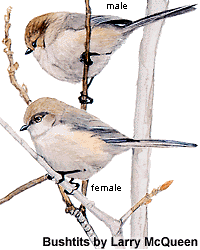Bobolink
(Dolichonyx oryzivorus)
| Cool fact: Bobolinks undertake the longest migration of any passerine species. The round-trip from the breeding grounds in southern Canada and northern United States to the pampas of Argentina, Paraguay and southwestern Brazil can cover more than 11,000 miles. |
 |
Most Bobolinks begin their autumn migration by moving eastward toward the southeastern Atlantic Coast, even those from the western parts of the breeding range (southern British Columbia and eastern Oregon and Washington). Then they rest and accumulate fat before the long passage across the Caribbean to South America. Some apparently take a more direct route south from their northeastern summer homes and fly away from the coast over the Atlantic; there are numerous records of Bobolinks migrating south over Bermuda.
Black Tern
(Chlidonias niger)
|
Cool fact: Unlike the familiar terns of the
genus Sterna, Black Terns rarely plunge-dive. Instead, they fly
with distinctive buoyant and erratic flight, almost bat-like, often
swooping low to pick up some food item from the surface of shallow
water. |
Preferred breeding habitat of Black Terns includes freshwater marshes, prairie sloughs, and lake edges. The male performs a display flight where he carries a small fish or dragonfly in view of potential mates. A female that accepts the invitation follows him to a perch where he feeds her the prize. Black Terns are semi-colonial nesters and only defend a small territory a few feet around the nest. Nests may be as close as 1 yard apart, but more typically they are 15 to 60 feet apart, in clusters of 10 to 50 nests. Both parents make the nest. The nest sites can be on top of muskrat houses, floating root masses, driftwood, or boards. Sometimes Black Terns may use an old coot or grebe nest. They do not usually carry nest materials in flight, but instead heave dead vegetation up from the water and arrange it in a small cup at the nest site. Both parents incubate the eggs. Nesting success is variable; nests are so flimsy and close to the water that they are often destroyed by wind and wave action. Hatchlings are semi-precocial and downy. They move about on the nest for about two weeks, and start to fly at three weeks.
Bushtit
(Psaltriparus minimus)
| Cool fact: The taxonomic placement of this tiny resident of the West and Southwest has changed over the years. Once thought of as two or even three species, all Bushtits are now considered one. This species has been removed from the titmouse and chickadee family and, together with six Old World species, is now placed in its own family, the long-tailed tits. |  |
Bushtits range from southern British Columbia south through
the west and southwestern United States to central Mexico and Guatemala.
They are most common in the United States in the West Coast states, especially
in the oak woodlands of California's Sacramento Valley and along the coast
and in the semiarid scrublands of the Southwest. They also occur in the
Rocky Mountains up to 2,440 meters, and in the savannas of the southern
Great Plains. Typical habitat includes open deciduous and mixed woodlands
with well-spaced trees and shrubs and edge habitats. Outside of the breeding
season, they may wander to higher altitudes in montane regions or to desert
lowland areas, but they avoid grasslands and the open arid desert. They
can also be found in parks and suburban areas, where they are attracted
to bird baths.
Bushtits are highly gregarious and have a complex social system. Outside
of the breeding season, which begins as early as mid-January, they travel
in flocks of 6 to 60 birds that are created by family groups joining together.
Flocks remain stable and may contain the same individuals from year to
year. Foraging flocks that glean for insects and spiders travel rapidly
through the brush, maintaining contact with high-pitched contact calls.
At times, they forage so rapidly that other birds, such as chickadees
and wrens that occasionally join them in a mixed-species flock, are left
behind. Bushtits roost together among dense branches and huddle closely
together on cold nights.
Common Yellowthroat | Bobolink | Northern Cardinal | Home